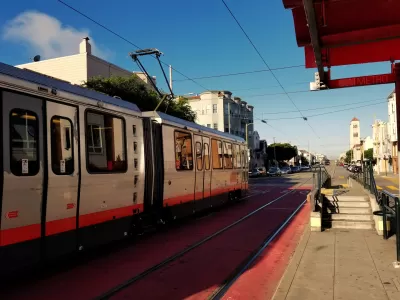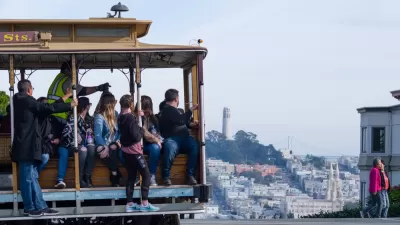The light rail line was supposed to improve transit to less accessible parts of the city, but service so far has been disappointing.

Rachel Swan reports on the T-Third Street Muni light rail line in San Francisco. The line runs through communities along the eastern side of the city, many of which are growing quickly. It was pitched as an alternative to local bus service and a quick and efficient way to move people from some of the city’s more far-flung neighborhoods.
But soon after the line opened in 2007, it was plagued with delays that have continued:
The T line’s problems appear to stem from its design. It hits about 60 intersections looping from Sunnydale to the Folsom portal, where it travels underground to Embarcadero Station and then changes signs to become the K-Ingleside. Most of those intersections have traffic signals that don’t always sync up to give trains priority over other vehicles.
In addition, says Swan, trains are slowed down by cars making illegal left-hand turns and on parts of route where trains share roads crowded with vehicle traffic.
Plans to improve service include using software to help trains get through lights and intersections more easily, addressing problem points on the route, and increasing train capacity by adding additional cars.
With the rapid growth in development in neighborhoods along the route and the demand in ridership that will result, whether these changes will fix the T line’s problems remains to be seen. In addition, residents say 23rd Street in the Dogpatch neighborhood marks the end of gentrification in the area, and they wonder if service improvements will benefit lower-income and more isolated communities to the south.
“Even so, politicians and transit officials still champion the T as a great social equalizer, saying it could pump business into the city’s most neglected neighborhoods and give those residents a quick link to the downtown core,” says Swan.
FULL STORY: The T line has never lived up to its promise. Coming upgrades may not be enough to help

Maui's Vacation Rental Debate Turns Ugly
Verbal attacks, misinformation campaigns and fistfights plague a high-stakes debate to convert thousands of vacation rentals into long-term housing.

Planetizen Federal Action Tracker
A weekly monitor of how Trump’s orders and actions are impacting planners and planning in America.

In Urban Planning, AI Prompting Could be the New Design Thinking
Creativity has long been key to great urban design. What if we see AI as our new creative partner?

King County Supportive Housing Program Offers Hope for Unhoused Residents
The county is taking a ‘Housing First’ approach that prioritizes getting people into housing, then offering wraparound supportive services.

Researchers Use AI to Get Clearer Picture of US Housing
Analysts are using artificial intelligence to supercharge their research by allowing them to comb through data faster. Though these AI tools can be error prone, they save time and housing researchers are optimistic about the future.

Making Shared Micromobility More Inclusive
Cities and shared mobility system operators can do more to include people with disabilities in planning and operations, per a new report.
Urban Design for Planners 1: Software Tools
This six-course series explores essential urban design concepts using open source software and equips planners with the tools they need to participate fully in the urban design process.
Planning for Universal Design
Learn the tools for implementing Universal Design in planning regulations.
planning NEXT
Appalachian Highlands Housing Partners
Mpact (founded as Rail~Volution)
City of Camden Redevelopment Agency
City of Astoria
City of Portland
City of Laramie





























